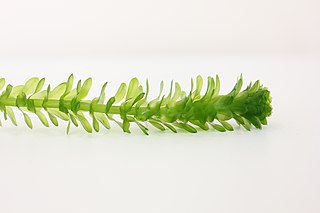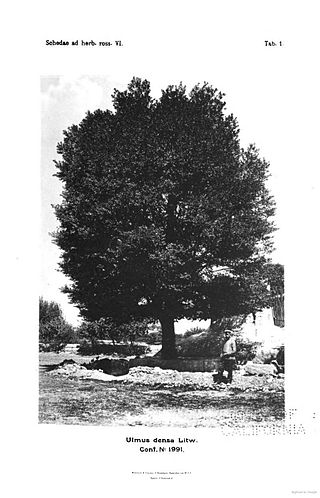
The juxtaglomerular apparatus is a structure in the kidney that regulates the function of each nephron, the functional units of the kidney. The juxtaglomerular apparatus is named because it is next to (juxta-) the glomerulus.

In the kidney, the macula densa is an area of closely packed specialized cells lining the wall of the distal tubule where it touches the glomerulus. Specifically, the macula densa is found in the terminal portion of the distal straight tubule, after which the distal convoluted tubule begins.
The basal lamina is a layer of extracellular matrix secreted by the epithelial cells, on which the epithelium sits. It is often incorrectly referred to as the basement membrane, though it does constitute a portion of the basement membrane. The basal lamina is visible only with the electron microscope, where it appears as an electron-dense layer that is 20–100 nm thick.
Densa has been used as the name of a number of fictional organizations parodying Mensa International, the organization for highly intelligent people. Densa is ostensibly an organization for people insufficiently intelligent to be members of Mensa. The name Densa has been said to be an acronym for "Diversely Educated Not Seriously Affected." The name Densa is a portmanteau of denser and Mensa.

Juxtaglomerular cells, also known as juxtaglomerular granular cells are cells in the kidney that synthesize, store, and secrete the enzyme renin. They are specialized smooth muscle cells mainly in the walls of the afferent arterioles that deliver blood to the glomerulus. In synthesizing renin, they play a critical role in the renin–angiotensin system and thus in autoregulation of the kidney.

The afferent arterioles are a group of blood vessels that supply the nephrons in many excretory systems. They play an important role in the regulation of blood pressure as a part of the tubuloglomerular feedback mechanism.
In the physiology of the kidney, tubuloglomerular feedback (TGF) is a feedback system inside the kidneys. Within each nephron, information from the renal tubules is signaled to the glomerulus. Tubuloglomerular feedback is one of several mechanisms the kidney uses to regulate glomerular filtration rate (GFR). It involves the concept of purinergic signaling, in which an increased distal tubular sodium chloride concentration causes a basolateral release of adenosine from the macula densa cells. This initiates a cascade of events that ultimately brings GFR to an appropriate level.
Yilmana Densa is one of the woredas in the Amhara Region of Ethiopia. Part of the Mirab Gojjam Zone, Yilmana Densa is bordered on the south by Kuarit, on the southwest by Sekela, on the west by Mecha, on the north by Bahir Dar Zuria, on the east by the newly established district Gonji kolela. The major town in Yilmana Densa is Adet. The district is well known for its potential in teff production and known as the ocean homeland of Magna teff.

The Field Elm cultivar Ulmus minor 'Umbraculifera' [:shade-giving] was originally cultivated in Iran, where it was widely planted as an ornamental and occasionally grew to a great size, being known there as 'Nalband' Persian: نعلبند [:the tree of the farriers]. Litvinov considered it a cultivar of a wild elm with a dense crown that he called U. densa, from the mountains of Turkestan, Ferghana, and Aksu. Non-rounded forms of 'Umbraculifera' are also found in Isfahan Province, Iran. Zielińksi in Flora Iranica considered it an U. minor cultivar.
Banksia densa is a species of column-like shrub that is endemic to Western Australia. It has deeply serrated to pinnatifid leaves, creamy yellow flowers in heads of up to seventy-five, and hairy follicles.
The lamina lucida is a component of the basement membrane which is found between the epithelium and underlying connective tissue. It is a roughly 40 nanometre wide electron-lucent zone between the plasma membrane of the basal cells and the (electron-dense) lamina densa of the basement membrane.

Egeria densa, the large-flowered waterweed or Brazilian waterweed, is a species of Egeria native to warm temperate South America in southeastern Brazil, Argentina, Chile and Uruguay. It is considered a problematic invasive species due to its use in home aquariums and subsequent release into non-native ecosystems.

Aspidotis densa is a species of fern in the Cheilanthoid subfamily, known by the common name Indian's dream or Serpentine fern or dense lace fern. It is native to the west coast of North America from British Columbia to California and east to the Rocky Mountains in Idaho, Montana, and Wyoming; there is a disjunct population on serpentine soils in Quebec.

Hypnaceae is a large family of moss with broad worldwide occurrence in the class Bryopsida, subclass Bryidae and order Hypnales. Genera include Hypnum, Phyllodon, and Taxiphyllum.

The elm cultivar UlmusDensa was described from specimens growing near Ashkabad as U. densaLitv. in Schedae ad Herbarium Florae Rossicae (1908). Litvinov, reporting it growing wild in the mountains of Turkestan, Ferghana, and Aksu, as well as in cultivation, considered it a species, a view upheld by the Soviet publications Trees and Shrubs in the USSR (1951) and Flora of Armenia (1962), and by some current plant lists. Other authorities take it to be a form of U minor, distinctive only in its dense crown and upright branching. The Moscow State University herbarium gives (2020) Ulmus minor as the "accepted name" of U. densaLitv..
Platygyriella is a genus of moss in the family Hypnaceae. It was described by Jules Cardot in 1854. It occurs mostly in the Americas, parts of Africa, and parts of Asia.
Platygyriella frahmii is a species of moss from the genus Platygyriella. It was first described as Pylaisiella frahmii by W.R. Buck in 1993 and transferred to Platygyriella by T. Arikawa in 2004. It is found in Africa at an elevation of 2100 meters.
Platygyriella fragilifolia is a species of moss in the genus Platygyriella. It was first described as Trachyphyllum fragilifolium by Hugh Neville Dixon in 1938. It was discovered in India and only occurs in Asia.
Platygyriella kirtikarii is a species of moss from the genus Platygyriella. It was discovered in Asia and only occurs in Asia. Before the name Platygyriella kirtikarii, it was named Bryosedgwickia kirtikarii by Cardot & Dixon.
Platygyriella jamaicensis is a species of moss belonging to the genus Platygyriella. It was discovered in Jamaica in 1936 by E.B. Bartram It has branches with a size length of about 1–1.5 cm (0.39–0.59 in). It has leaves with the length of about 1.4 mm (0.055 in) with an erect top, straight edges, and curved below. It has perichaetal erect leaves spreading, plant with 4–6 mm (0.16–0.24 in) leaves, which are very smooth and thin with an oblong-cylindrical and can reach up to 1.4 mm (0.055 in). It has a basilar crown with are 15–20 μm and yellow.







